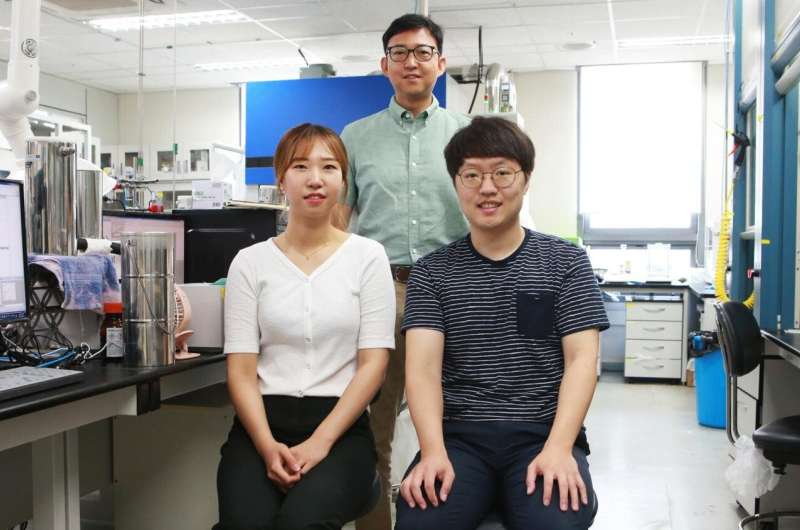DGIST Professor Jaeheung Cho in the Department of Emerging Materials Science at DGIST (up), Bohee Kim, a Combined M.S-Ph.D. Program Student in the Department of Emerging Materials Science (below left), and Donghyun Jeong, a Combined M.S-Ph.D. Program Student. Credit: DGIST
A DGIST research team succeeded in synthesizing new biomimetic materials that will increase the efficiency of chemical reaction related to body metabolism, and discovered that synthesized materials cause the oxidation of aldehydes. The results are expected to have positive impacts on catalyst development in the future.
DGIST announced that Professor Jaeheung Cho's team in the Department of Emerging Material Science developed 'copper(II)-hydroperoxo complex,' a biomimetic compound that conducts aldehyde deformylation. This complex is drawing attention in bioinorganic fields due to its higher efficiency than the existing complexes which cause a deformylation reaction.
'Deformylation reaction' is a type of oxidation reaction that deformylates the double-bond structure of carbon and oxygen inside an aldehyde or ketone compound in a different form. It is especially important in chemical reactions in various ways, for example, by controlling the conversion of a steroid with a sex hormone or by converting the fat aldehyde formed during fat reduction. To synthesize biomimetic compounds, the research team added 'hydroperoxo,' a combination of electrons and protons with an oxygen molecule, to a copper compound. The 'copper(II)-hydroperoxo complex' formed here boasts much higher efficiency in deformylation reaction than other existing materials.
This the first time that copper(II)-hydroperoxo adduct has been directly involved in a deformylation reaction.
Professor Jaeheung Cho in the Department of Emerging Materials Science at DGIST said "We believe we've expanded the research scope of materials involved in deformylation reaction, which plays an important role in biological systems. We will continue our research on materials or methods that have higher efficiency and controllability in deformylation reaction," and explained his follow-up research plans.
More information: Bohee Kim et al, Nucleophilic reactivity of a copper(II)-hydroperoxo complex, Communications Chemistry (2019). DOI: 10.1038/s42004-019-0187-3
Provided by DGIST (Daegu Gyeongbuk Institute of Science and Technology)
























